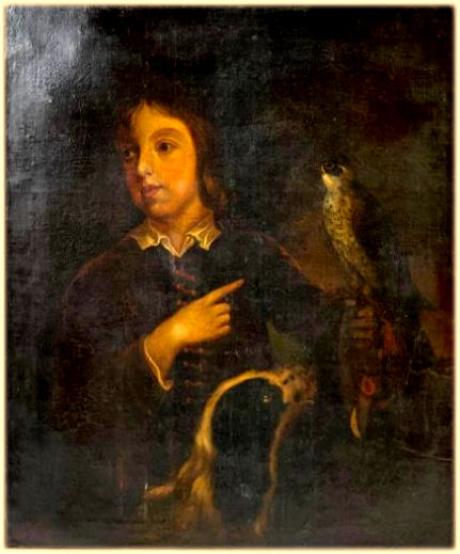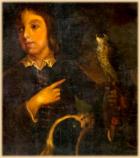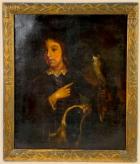Thomas Beach carried out three full length portraits for Sir Edward Turner 2nd Bt 1719-1766 , all the portraits were of his children , Elizabeth, Gregory , John and Cassandra. William did not feature in the full length portraits but was painted on his own in a half length portrait. William (1750-1819) was educated at Magdalen College, Oxford (B.A.1767). He married leaving issue (daughters).admitted to Lincolns Inn , Dec 1775. In all of the full length Portraits of the Turner children, dogs were included in the composition.
Historically, falconry was a popular sport and status symbol among the nobles of medieval Europe,and Asia. Many historical illustrations left in Rashid al Din's "Compendium chronicles" book described falconry of the middle centuries with Mongol images. Falconry was largely restricted to the noble classes due to the prerequisite commitment of time, money, and space. In art and other aspects of culture, such as literature, falconry remained a status symbol long after it was no longer popularly practiced. The historical significance of falconry within lower social classes may be underrepresented in the archaeological record, due to a lack of surviving evidence, especially from nonliterate nomadic and nonagrarian societies. Within nomadic societies such as the Bedouin, falconry was not practiced for recreation by noblemen. Instead, falcons were trapped and hunted on small game during the winter to supplement a very limited diet.
In the UK and parts of Europe, falconry probably reached its zenith in the 17th century,but soon faded, particularly in the late 18th and 19th centuries, as firearms became the tool of choice for hunting. (This likely took place throughout Europe and Asia in differing degrees.) Falconry in the UK had a resurgence in the late 19th and early 20th centuries when a number of falconry books were published. In 1801 – Joseph Strutt of England writes, "the ladies not only accompanied the gentlemen in pursuit of the diversion [falconry], but often practiced it by themselves; and even excelled the men in knowledge and exercise of the art."
It is recorded that the Dukes of Gordon sustained Scottish falconry and retained professional falconers throughout the 18th century, and further south the 3rd Earl of Orford was an active falconer from the 1740s. However Grassby's assertion that" ... the sport had to be virtually re-created in England when Orford and Colonel Thornton founded the Falconers Club in 1771. Falconry stagnated and then faded away slowly, largely without notice or comment." (1997 pp52), is open to question. What Grassby calls 'the Falconers Club', and was actually the name used for the club after Thornton ceased to be involved with it, more accurately titled the Confederate Hawks of Great Britain was in reality an expression of the resilience and the adaptive qualities of those who would fly hawks and falcons. Far from stagnating, the sport was experiencing an organisational shift that would help to ensure its survival. If taken together with Campbell's 1773 publication and the knowledge that a small club had been in operation in Renfrewshire for a number of years, Grassby's sentiments can be refuted. Where Grassby can be supported however, is in his assessment of the philosophical environment that faced the falconers of the period. The link with nature had indeed been ruptured by the development of a scientific rationality, capitalism and the associated demands of property. The seat of power had shifted irrevocably away from the land to the city and the burgeoning urban dynamic was becoming more influential with demands of utility and productivity. Whilst Britain was still predominantly a rural society: its heart, its driving force and defining culture was becoming that of the industrial city. The section of society that had traditionally accompanied the falcons and supported the sport, the elite, spent more time in the towns and cities. The countryside and all that it contained became unfashionable and falconry lost the cachet that had hitherto been gained through the participation of those of the highest status.
Thomas Beach was born at Milton Abbas, Dorset in 1738, and showed. a strong predilection for art from an early age.portrait painter, was baptized at Abbey Milton, Dorset, on 4 April 1737, the second son of Thomas Beach and his wife, Ursula, née Bryer. He was educated at the grammar school in Abbey Milton, where he had shown such distinct artistic promise that Lord Milton sent him to London to study with Sir Joshua Reynolds from 1760 to 1762, when he was also enrolled at the St Martin's Lane Academy. In 1760, under the patronage of Lord Dorchester's family, he became a pupil of Sir Joshua Reynolds, while at the same time studying at the St. Martin's Lane Academy.By 1770 he had settled at 2 Westgate Buildings, Bath, where he soon acquired a profitable reputation among fashionable visitors and residents. In 1772 he joined the Incorporated Society of Artists, contributing to its annual exhibitions until 1783, when, like so many of his contemporaries, he changed his allegiance to the Royal Academy, where he showed from 1785 to 1790 and in 1797, when he exhibited a portrait of the prince of Wales (Royal Collection). During that time he was partly resident in London living at 3 Charles Street, St James's Square, and later at 54/55 Wigmore Street; like other artists, he followed the bon ton in its seasonal ebb and flow between the capital and Bath. The date of his marriage to Maria, née Vaughan, of whom he made a portrait (ex Sothebys, 23 March 1977), is unknown. It appears that she died before 1797, for from that year his sister, Frances, kept house for him. The couple were childless.
He then settled at the fashionable resort of Bath, where he was much in demand for his portraits and portrait groups, which were usually of a small size.
He painted the actress Sarah Siddons several times. In his first portrait of her, painted in the winter of 1781–2, she is shown seated, in everyday clothes, holding a book. He depicted her again later in 1782, in one of his more ambitious works, an allegorical portrait inspired by Milton's Il Penseroso, in which she represented the personification of Melancholy. In 1787 he painted Mrs. Siddons and John Kemble in the Dagger Scene in Macbeth, of which the actress wrote, "My brother's head is the finest I have ever seen, and the likest of the two".
Like most provincial portrait painters of the time, Beach was dependent on the local patronage of the landowners. At Bath and London he also established a cosmopolitan clientele, including actors and critics whom he met through his interest in the theatre. One of his early portraits is of the actor John Henderson (1773; Garrick Club, London), with whom he was linked in a contemporary couplet:
Happy life's duties with its joys to blendReynolds his master, Henderson his friend.
Notes and Queries for Somerset and Dorset, 9, 1905, 67In 1782 he made two portraits of Sarah Siddons, who was performing that year in Bath. One, a formal portrait (Auckland Art Gallery, New Zealand), shows her looking up from an open book, as though she was learning a part, and may have been painted that summer in Dorset (Beach, 15). The second, inspired by Milton's Il Penseroso, portrayed her as Melancholy (ex Sothebys, 10 November 1992). Other theatrical portraits included those of Giusto Tenducci, an Italian castrato and noted opera singer (1782; priv. coll.), John Philip Kemble and Sarah Siddons in the dagger scene from Macbeth (1786; Garrick Club, London), and George Steevens, the Shakespearian commentator (c.1773–4; Dunedin Art Gallery, New Zealand), on the publication of his edition of Shakespeare's plays.
He was a member of the Incorporated Society of Artists, and a contributor to its exhibitions from 1772 to 1783. He exhibited the Royal Academy every year from 1785 until 1790, but not again until 1797, when he was living at Strand-on-the-Green, near Kew in London, and sent a portrait of the Prince of Wales. Several of Beach's portraits were engraved in mezzotint by William Dickinson, Valentine Green, Richard Houston, and John Jones. Beach was an assured figure painter and natural colourist, and was noted for his ability to capture a good likeness. Often in a feigned oval, his portraits were frequently signed and dated. Where appropriate he added an air of spontaneity by showing the sitter's head tilted and the mouth slightly open, to give an impression of the sitter speaking, an impression that was heightened by placing the sitter close to the front plane of the composition. His group portraits display a pleasing and provincial informality of arrangement, for example, The Stapleton Family (1789; Holburne Museum of Art, Bath). In 1798 he kept a diary, which, according to Elise Beach, great-great-grandniece and his biographer, was so prosaic that it recorded both the completion of thirty-one portraits and the time he went to bed each night. It was probably towards the end of that year that he decided to retire to Dorchester in Dorset. He continued to paint until at least 1802, the date of his Self-Portrait (National Portrait Gallery, London). Beach died in Dorchester, on 17 December 1806. In her biography Elise Beach listed 308 portraits by Beach.
Beach died at Dorchester, Dorset, on 17 December 1806.
The National Portrait Gallery has a portrait by Beach of William Woodfall, the earliest parliamentary reporter. Portraits of Sir Edward Wilmot, bart., M.D., and Richard Tattersall, the horse dealer who established 'Tattersall's, were exhibited in the National Portrait Exhibition of 1867.



